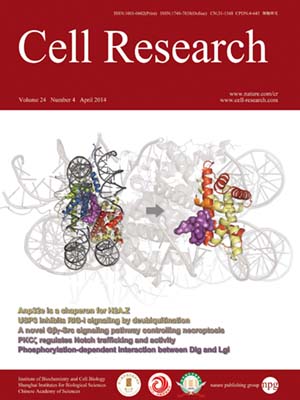
Volume 24, No 4, Apr 2014
ISSN: 1001-0602
EISSN: 1748-7838 2018
impact factor 17.848*
(Clarivate Analytics, 2019)
Volume 24 Issue 4, April 2014: 501-504
LETTERS TO THE EDITOR
Rosa26-targeted swine models for stable gene over-expression and Cre-mediated lineage tracing
Xiaoping Li1,*, Yi Yang1,*, Lei Bu4, Xiaogang Guo2, Chengcheng Tang1, Jun Song2,3, Nana Fan2, Bentian Zhao2, Zhen Ouyang2, Zhaoming Liu2, Yu Zhao2, Xiaoling Yi2, Longquan Quan1, Songcai Liu1, Zhenguo Yang1, Hongsheng Ouyang1, Y Eugene Chen3, Zhong Wang3 and Liangxue Lai1,2
1Jilin Provincial Key Laboratory of Animal Embryo Engineering, Institute of Zoonosis, College of Veterinary Medicine, Jilin University, Changchun 130062, China
2Key Laboratory of Regenerative Biology, Chinese Academy of Sciences, Guangdong Provincial Key Laboratory of Stem Cells and Regenerative Medicine, Guangzhou Institutes of Biomedicine and Health, Guangzhou, Guangdong 510530 China
3Department of Cardiac Surgery, Cardiovascular Research Center, University of Michigan, 2800 Plymouth Road, Ann Arbor, MI 48109, USA
4Leon H Charney Division of Cardiology, New York University School of Medicine, 522 First Avenue, New York, NY 10016, USA
Correspondence: Liangxue Lai, E-mail: lai_liangxue@gibh.ac.cn; Zhong Wang, E-mail:(zhongw@med.umich.edu)
Genetic modification of pigs has many agricultural and biomedical applications. Ectopic overexpression of foreign genes is necessary in many cases to generate transgenic pigs with favorable phenotypes1. However, random integration of foreign genes often leads to unpredictable expression and unstable phenotypes2. Rosa26 is ubiquitously expressed in embryonic as well as adult tissues3. Targeting genes to the Rosa26 locus is a desirable method to create transgenic animals consistently expressing foreign genes at a high level. Insertion of a reporter or toxin gene into the Rosa26 locus has been widely used to trace or ablate specific cell lineages4, and this approach plays a fundamental role in understanding cell differentiation in vivo. Rosa26 was first identified and targeted in mouse embryonic stem cells (ESCs) in 1990s3, and then in human ESCs in 20075. With the establishment of rat pluripotent stem cells, the Rosa26 locus was also successfully identified and targeted in rats recently6. However, Rosa26 has not been tackled in large animals due to unavailability of germline-competent pluripotent stem cells. By taking advantage of recently emerging technology of gene editing mediated by transcription activator–like effector nuclease (TALEN)7, here we characterized the porcine Rosa26 (pRosa26) locus and targeted a Cre-dependent reporter gene into the pRosa26 locus. Using this approach, we also created transgenic pigs stably overexpressing a gene of interest through recombinase-mediated cassette exchange (RMCE)5.
10.1038/cr.2014.15
FULL TEXT | PDF
Browse 2833


